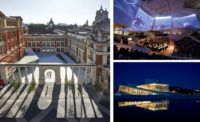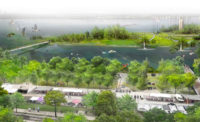This week, the Harvard Graduate School of Design (GSD) unveiled its restoration of Richard Rogers’ Wimbledon House in London. The Heritage-listed building, formerly known as the Rogers House, will house living and learning spaces for the first class of international students selected for the GSD’s Richard Rogers Fellowship, as well as various symposia.
Rogers originally designed the transparent, steel-framed house with his late wife Su Rogers for his parents in the late 1960s and donated it to Harvard in 2015 through his foundation, the Richard Rogers Charitable Settlement. He enlisted local architect Philip Gumuchdjian of Gumuchdjian Architects—formerly an associate director at Rogers’ own firm—to convert it into the home of the fellowship program while preserving its essential qualities. With the help of landscape architect Todd Longstaffe-Gowan, Gumuchdijan carried out a two-year refurbishment that intensified the vibrant hues, rhythmic composition, and indoor-outdoor blending—qualities that inspired Rogers’ work with Renzo Piano on Paris’ Centre Pompidou.
“Parkside is not just an iconic, flexible machine for living, nor simply a historic experimental building that foretold the architect’s future work,” Gumuchdijan said in a statement. “It was also a home with a unique memory, patina, and aura. Conserving these qualities within a wholly refurbished twenty-first-century building tailored to Harvard’s use was our aim and hopefully the achievement of the team’s work.”
The Richard Rogers fellowship began last October with the goal of continuing Rogers’ legacy in cross-disciplinary investigation and social engagement—creating a “dynamic that flows when different disciplines, from sociology to mathematics, engineering to philosophy come together,” according to Rogers.
The three-month residency welcomes candidates from all over the world to participate in interdisciplinary research on the many factors that influence contemporary cities. The first class of fellows consists of six architects whose areas of study range from affordable housing to the implications of cooking in urban environments. Applications for next year’s fellowships will open this fall.




















Post a comment to this article
Report Abusive Comment